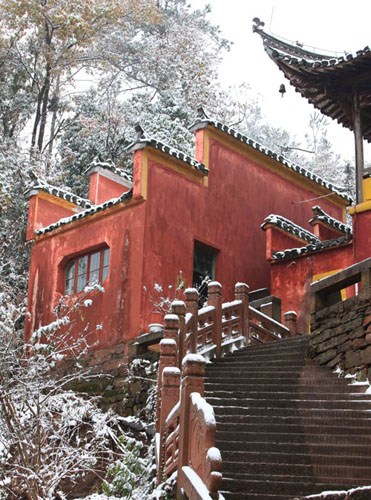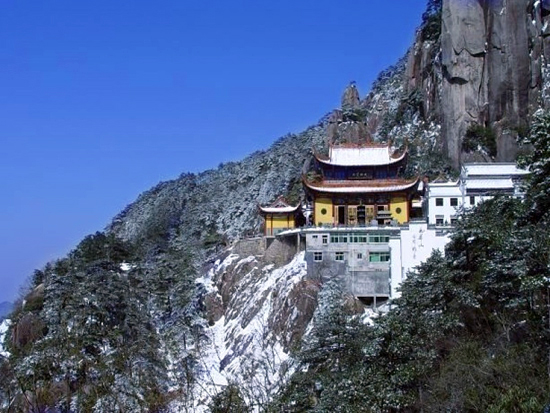As our gondola rose higher and higher, our view of the surrounding land broadened. Below us rapeseed fields were in full blossom, lending a golden splash to the riverbanks and valley floors. Scattered among the yellow were clusters of cottages constructed in the style typical of the area – white walls and dark tile roofs. It was an idyllic picture of the countryside, and one that seemed – to us in our gondola, at least – untouched by time or trend.

Reaching a lower peak, we hopped out of our cablecar and found ourselves at the Wangxian (Watching the Immortals) Pavilion. Following our guide, Mr. Wang, we walked down the Peach Blossom Valley towards Dongtianfudi, the Taoist appellation for the “residence of immortals” that literally means “a sacred spot concealed from the outside world.” There are many Taoist sites in China of the same name, but this one stands out due to its abutting the Peach Blossom Valley. Such a valley is a metaphor for Lost Paradise in Chinese.
Dongtianfudi is the site of Zhang Sanfeng’s tomb. Also in the area are three examples of fine cliff carvings at the Xizhen, Zhonglie and Shouzi rock faces.
Mr. Wang is from one of the mountain’s traditional Taoist families. His grandfather and father were both abbots at a local Taoist monastery, and he is a pious believer himself. Wang sees Mt. Qiyun as different from other Taoist holy sites. For one, it is open to both religious and secular communities, and non-Taoists reside alongside the faithful in the mountain’s villages. This mixing can be best seen along Yuehua Street, where a motley collection of buildings – some cloisters, some residences and some plain old shops – jostle for spiritual and commercial customers.
Almost all visitors make a stop at the Mengzhen Bridge in Peach Blossom Valley. Many tie a yellow ribbon on its stone rails after making a wish. Mengzhen actually translates as “a dream coming true” in Chinese. The bridge leads to a flagstone path built during Ming Dynasty Emperor Zhengde’s reign (1506-1522). Mosses grow on the stones, undergoing centuries of pilgrims’ treading.
Hermits and Deities

We recommend:
